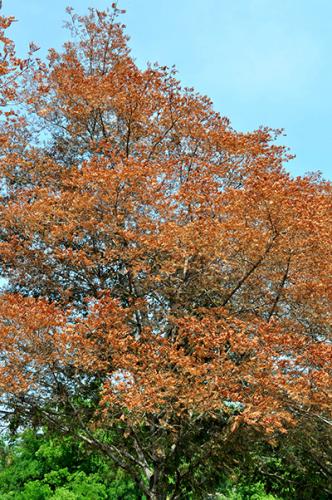Bagworms: Don’t let them bag your nursery stock
Bagworms are becoming an insect pest that Michigan nurseries need to scout for. Lifecycle, damage and control measures are discussed.

Bagworms, Thyridopteryx ephemeraeformis (Haworth), is an insect pest that can cause defoliation to conifers like arborvitae, juniper, pine, spruce as well as many deciduous plants such as black locust, Norway maple and many shrubs. Most often, we think of this pest as a problem in southern states east of the Mississippi River. However, in recent years more reports of damage and defoliation from bagworms have been noted in states like Indiana and Ohio. It has been observed in southern Michigan on occasion and even known to cause damage to wild huckleberry in Michigan’s Upper Peninsula, probably overwintering extremely well under the abundant snow cover.
Female bagworms lay from 500-1,000 eggs each year in the fall before they die. Eggs will hatch in the spring months of May and June. After emerging, the young larvae can “balloon down” on silken threads to other portions of an infested plant or can blow around on winds to other plants. This is a similar habit to the “ballooning” that young gypsy moth larvae do.
Once the larvae land on a plant, they will spin a bag of silk and plant debris. They live in this structure, which may look like an upside down ice cream cone as described by some entomologists. The larvae feed and continue to grow and the bag grows in size, firmly attached to a twig on the plant. Bagworms feed for six to eight weeks and if numbers are high enough on a conifer, they can strip all the needles or devour all the leaves off a deciduous plant.
In September, the mature larvae will pupate. Adult males emerge from the bag and fly and look to mate with adult females. Females are not capable of flying and remain on the plant they have fed on all season. After the female lays eggs in the fall, she will die and the eggs remain in the bag until the following spring when they hatch.
 Michigan State University Extension advises nursery growers to scout nursery stock they receive from states to the south to be sure they are clean from this pest. Scouting for early feeding damage from this pest can be challenging because these caterpillars feed only on a small area of the foliage and only the epidermis is removed. Only when the bags are easy to see on the plant is wide scale damage from their feeding easily seen. Nursery growers need to scout for the bags in the fall or early spring. Remember the old bags will contain eggs that will hatch in the spring.
Michigan State University Extension advises nursery growers to scout nursery stock they receive from states to the south to be sure they are clean from this pest. Scouting for early feeding damage from this pest can be challenging because these caterpillars feed only on a small area of the foliage and only the epidermis is removed. Only when the bags are easy to see on the plant is wide scale damage from their feeding easily seen. Nursery growers need to scout for the bags in the fall or early spring. Remember the old bags will contain eggs that will hatch in the spring.
Control measures are best done when small larvae are detected, usually mid-June or 600-900 growing degree days. Hand removal is one option for lite infestations. If the population of bagworm is significant, insecticides that control caterpillars are suggested. Please note that the active ingredient in some of the insecticides listed below may cause outbreaks of spider mites since they kill natural enemies of spider mites. We suggest you choose insecticides that are compatible with natural enemies if spidermite management is a concern with the plants you are treating. Read the label for any restrictions, re-entry times, etc.
Bagworm controls in nurseries (active ingredient)
- Acephate
- Acetamiprid*
- Azadirachtin*
- Bacillus thuringiensis*
- Beauveria bassiama*
- Bifenthin
- Carbaryl
- Cyfluthrin
- Spinosad*
- Tebufenozide*
*These products are compatible with beneficial insects and should not lead to spidermite outbreaks.
For additional assistance on nursery crop issues, please contact your local MSU extension educator for production nurseries.



 Print
Print Email
Email

